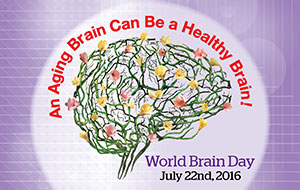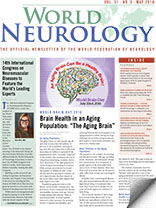Brain Health in an Aging Population: “The Aging Brain”
By Mohammad Wasay, MD, FRCP, FAAN, and Wolfgang Grisold, MD
An Aging Population
 The global share of older people (age 60 and over) is more than 800 million (12 percent of the population) and is growing, with the expectation that it will reach more than two billion (21 percent of the population) by 2050. Currently 70 percent of the world’s older population lives in developed and developing countries, but by 2025, 80 percent of the older population will be living in less developed countries. Older persons are projected to exceed the number of children in 2047. It has already started in developed countries. In 2015, Japan became the first country in the world where more adult diapers than baby diapers were sold.
The global share of older people (age 60 and over) is more than 800 million (12 percent of the population) and is growing, with the expectation that it will reach more than two billion (21 percent of the population) by 2050. Currently 70 percent of the world’s older population lives in developed and developing countries, but by 2025, 80 percent of the older population will be living in less developed countries. Older persons are projected to exceed the number of children in 2047. It has already started in developed countries. In 2015, Japan became the first country in the world where more adult diapers than baby diapers were sold.
Population aging has major social, health, and economic consequences. The prevalence of non-communicable diseases and disability increases with age. Poverty is high among older persons. There is increased pressure on social support systems for older persons. The growing burden of diseases and disability, and reducing financial and social support in an aging population will be among the huge challenges for societies and governments with respect to their social and health care systems in coming years.
Brain Diseases in the Aging Population
The prevalence of a number of neurological diseases increases with age, including stroke, dementia, and Parkinson’s disease. It is estimated that 10 to 20 percent of people aged 60 to 80 years suffer from one or more of these diseases. More than 30 percent of persons who are 80 years or older suffer from at least one neurological disease.
Disability due to neurological diseases and other musculoskeletal diseases is very high and growing. It is estimated that more than 20 percent of people over 60 years old need support for activities of daily living.
The economic burden of this is huge. It is estimated that almost half of the health care expenditure is related to the care of older persons in developed countries today, and it is projected to become two-thirds by 2030. The same trends are expected in developing and less developed countries by 2050.
The medical community, however, must be cautious on the wording when “burden” with regards to costs of the aging populations is mentioned. We need to be aware that the word “burden” has a potentially negative connotation, which rather should be replaced with a more positive wording— which we feel is better stated as a responsibility.
World Brain Day Theme: “Brain Health in an Aging Population”
It is clear that brain health is going to be the most important determinant of social and economic well being of older persons in the future. On the one hand, health care authorities are deeply concerned with the current status and future trends of our growing population, but little has been done to handle these growing needs.
The World Federation of Neurology has stepped forward to dedicate this year’s World Brain Day to the aging population and has chosen the motto: “The aging brain.” Our intention for this World Brain Day is to increase awareness about the treatment and prevention of brain and neuromuscular diseases affecting mostly elderly persons. The first step of prevention is to improve concepts and means of brain health also among the younger population in order to help prevent brain disease later in life and to improve the quality of life for older persons.
Disease prevention is the concept. However, a much larger number of individuals will be affected by diseases of the brain and the neuromuscular system, which are not (yet) preventable. Thus it is also the duty of society to care for the elderly with progressed neurological disease, and to provide the framework for quality of life, dignity, and the necessary care.
In this group of patients, the focus has to shift from the aspect of a curative condition, towards the inevitable death of all individuals. The concept of palliative care and hospice needs to be implemented in the aging population and in neurological care.
How Can we Improve Brain Health and Prevent or Treat Neurologic Diseases and Care for Persons with Advanced Brain Disease?
Stroke and vascular dementia are among the most important neurological diseases affecting persons of higher age. For these conditions, there are preventable and modifiable risk factors. Education, cognitive exercises, physical activity, and nutrition are important areas of intervention for prevention and slowing down of cognitive decline. Parkinson’s disease is a neurodegenerative disorder, but effective symptomatic treatment is available.
Emotional health is as important as cognitive health in elderly persons. Quality of life and a lack of disability can be associated with emotional well-being. Effective interventions are available for maintenance and promotion of emotional health.
Despite prevention strategies, age is a non-modifiable risk factor, just as effects of degenerative and hereditary diseases on the brain and the neuromuscular system. Supportive, palliative care, and the hospice concept need to be integrated into the concept of neurological care in dealing with an aging population.
WFN and National Societies Activities
To raise awareness with respect to the aging brain and neurologic diseases in the elderly, the WFN is asking its members to use this year‘s “Day of the Brain” to advocate and campaign in their country for these emerging problems.
The WFN public awareness and advocacy committee will prepare publicity material for this campaign, which includes logos, banner ads for web sites, handbills, brochures, posters, billboards, and presentations.
There will be a press conference. A template press release will be prepared and circulated to delegate societies. They can be adapted for local use with respect to national/regional data, priorities, or by adding quotes from national/regional experts.
The most important target of this campaign is the public. We need to create simple messages in local languages and promote them via print, electronic and social media, billboards, banner, events, etc.
Other important areas of intervention are health care authorities and policy makers. Our campaign should result in policy and priority shift at the national or local level. We have to plan targeted activities to facilitate this outcome.
Another important area of intervention is awareness and training of general practitioners, nurses, and paramedical staff.
Involvement of the media is a must. Celebrities or scientists could be a part of this advocacy campaign.
Delegate societies are strongly encouraged to organize awareness activities that may include press conferences, media briefing sessions involving local media, seminars, conferences, public awareness sessions, presentations at local schools, colleges, universities, posters, essays, drawing competitions, and newspaper and magazine articles.
Collaborators
As in the past, the WFN will work with various health entities, and professional and welfare organizations to promote awareness for World Brain Day.
The WFN is hoping for your collaboration to improve the health and future of patients with an aging brain. Please follow our website, www.worldneurologyonline.com and our social media. If you have suggestions, or ideas for World Brain Day 2017, please do not hesitate to contact us at wbd2016@wfneurology.org.
